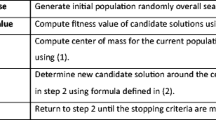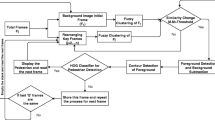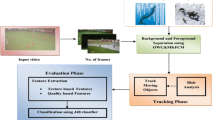Abstract
Background subtraction (BS) is one of most commonly used methods for detection of moving objects in videos that works by subtracting current frame from a background frame. Effective background modeling and threshold plays a crucial role in BS and can govern accuracy and preciseness of object boundaries. This paper proposes a fuzzy entropy based approach modified BS algorithm for moving object detection with Kalman tracker. The standard BS method has been enhanced using concept of fuzzy 2-partition entropy and big bang big crunch optimization (BBBCO). BBBCO has been used to enhance standard BS algorithm for extracting various parameters required in BS algorithm by framing the problem of parameters detection as optimization problem which is solved using concept of fuzzy partition entropy. The proposed algorithm generates optimal threshold values along with various other measures for background modeling. The detected objects are further tracked using Kalman filter based tracker. The evaluation of proposed method has been done on videos from benchmark datasets and statistical parameters have been calculated. The method is also compared with standard BS and another recent study in the field. The results show promise of the proposed method.




























Similar content being viewed by others
Explore related subjects
Discover the latest articles, news and stories from top researchers in related subjects.References
Arroyo, R., Yebes, J. J., Bergasa, L. M., Daza, I. G., Almazan, J., et al. (2015). Expert video-surveillance system for real-time detection of suspicious behaviors in shopping malls. Expert Systems with Applications, 42(21), 7991–8005.
Bouwmans, T. (2014). Traditional and recent approaches in background modeling for foreground detection: An overview. Computer Science Review, 11–12, 31–66.
Chen, Z., & Ellis, T. (2014). A self-adaptive Gaussian mixture model. Computer Vision and Image Understanding, 122, 35–46.
Cheng, H. D., Chen, J. R., & Li, J. G. (1998). Threshold selection based on fuzzy c-partition entropy approach. Pattern Recognition, 31, 857–870.
Erol, O. K., & Eksin, I. (2006). A new optimization method: Big bang–big crunch. Advances in Engineering Software, 37, 106–111.
Filho, M., Ma, Z., & Tavares, J. M. (2015). A review of the quantification and classification of pigmented skin lesions: From dedicated to hand-held devices. Journal of Medical Systems, 39(11), 177.
Goyette, N., Jodoin, P.-M., Porikli, F., Konrad, J., & Ishwar, P. (2012). changedetection.net: A new change detection benchmark dataset. In Proceedings of the IEEE workshop on change detection (CDW-2012) at CVPR-2012. Providence, RI, 16–21 June.
Heikkila, J., & Silven, O. (1999). A real-time system for monitoring of cyclists and pedestrians. In Proceeding of 2nd IEEE workshop on visual surveillance at fort collins, USA, 20 July (pp 74–81).
http://groups.inf.ed.ac.uk/f4k/F4KDATASAMPLES/INTERFACE/DATASAMPLES/search.ph. Accessed on April 2016.
http://homepages.inf.ed.ac.uk/rbf/CAVIARDATA1/. Accessed on April 2016.
http://perception.i2r.a-star.edu.sg/bkmodel/bkindex.html. Accessed on April 2016.
http://web.itu.edu.tr/okerol/BBBC.html. Accessed on April 2016.
Jodas, D. S., Pereira, A. S., & Tavares, J. M. R. S. (2016). A review of computational methods applied for identification and quantification of atherosclerotic plaques in images. Expert Systems with Applications, 46, 1–14.
Kalman, R. E. (1960). A new approach to linear filtering and prediction problems. Journal of Basic Engineering, 82(1), 35–45.
Karasulu, B., & Korukoglu, S. (2010). A software for performance evaluation and comparison of people detection and tracking methods in video processing. Multimedia Tools and Applications,. doi:10.1007/s11042-010-0591-2.
Karasulu, B., & Korukoglu, S. (2012). Moving object detection and tracking by using annealed background subtraction method in videos: Performance optimization. Expert System with applications, 39, 33–43.
Kasturi, R., Goldgof, D., Soundararajan, P., Manohar, V., Garofolo, J., Bowers, R., et al. (2009). Framework for performance evaluation of face, text, and vehicle detection and tracking in video: Data, metrics, and protocol. IEEE Transactions on Pattern Analysis and Machine Intelligence, 31(2), 319–336.
Lazarevic-McManus, N., Renno, J. R., Makris, D., & Jones, G. A. (2008). An object-based comparative methodology for motion detection based on the F-measure. Special Issue on Intelligent Visual Surveillance Understanding, 111(1), 74–85.
Li-juan, Q., Zhuang Yue-ting, W., Wu, F., & Pan, Y. (2005). Video segmentation using maximum entropy model. Journal of Zhejiang University Scinece, 1009–3095, 47–52.
Ling, Q., Yan, J., Li, F., & Zhang, Y. (2014). A background modeling and foreground segmentation approach based on the feedback of moving objects in traffic surveillance systems. Neurocomputing, 133(8), 32–45.
Ma, Y.-F., & Zhang, H.-J. (2001). Detecting Motion object by spatio-temporal entropy. In IEEE International conference on multimedia and expo (pp 265–268).
Ma, Z., Joao, M. R. S. T., & Renato, N. J. (2009). A review on the current segmentation algorithms for medical images. In 1st International conference on imaging theory and applications, Portugal (pp. 135–140). ISBN: 978-989-8111-68-5.
Ma, Z., Tavares, J. M. R. S., Jorge, R. N., & Mascarenhas, T. (2010). A review of algorithms for medical image segmentation and their applications to the female pelvic cavity. Computer Methods in Biomechanics and Biomedical Engineering, 13(2), 235–246.
Makris, D., & Ellis, T. (2002). Path detection in video surveillance. Image and Vision Computing, 20(12), 895–903.
Mandellos, N. A., Keramitsoglou, I., & Kiranoudis, C. T. (2011). A background subtraction algorithm for detecting and tracking vehicles. Expert Systems with Applications, 38(3), 1619–1631.
Nascimento, J. C., & Marques, J. S. (2006). Performance evaluation of object detection algorithms for video surveillance. IEEE Transactions on Multimedia, 8(4), 761–774.
Oliveira, R. B., Filho, M. E., Ma, Z., Papa, J. P., Pereira, A. S., João, M., et al. (2016). Computational methods for the image segmentation of pigmented skin lesions: A review. Computer Methods and Programs in Biomedicine, 131, 127–141.
Piccardi, M. (2004). Background subtraction techniques: A review. In IEEE international conference on systems, man and cybernetics at The Hague, The Netherlands (Vol. 4, pp. 3099–3104).
Pinho, R. R., João, M. R., & Tavares, S. (2009). Tracking features in image sequences with Kalman filtering. Global optimization, mahalanobis distance and a management model. Computer Modeling in Engineering and Sciences, 46(1), 51–75.
Pinho, R. R., João, M. R., Tavares, S., & Correia, M. C. (2007). An improved management model for tracking missing features in computer vision long image sequences. WSEAS Transactions on Information Science and Applications, 1(4), 196–203.
Pinho, R. R., João, M. R., Tavares, S., & Correia, M. V. (2005). A movement tracking management model with kalman filtering, global optimization techniques and mahalanobis distance, Lecture Series on Computer and Computational Sciences, 4A (Vol. 1, pp. 463–466). Brill Academic Publishers.
Richter-Trummer, V., Marques, E. A., Chaves, F. J. P., Tavares, J. M. R. S., da Silva, L. F. M., & de Castro, P. M. S. T. (2009). Analysis of the crack growth behavior in a double cantilever beam adhesive fracture test using digital image processing techniques. In 7th EUROMECH solid mechanics conference- ESMC 2009, Portugal (pp. 223–224). ISBN: 978-989-96264-2-3.
Richter-Trummer, V., Marques, E. A., Chaves, F. J. P., Tavares, J. M. R. S., da Silva, L. F. M., & de Castro, P. M. S. T. (2011). Analysis of crack growth behavior in a double cantilever beam adhesive fracture test by different digital image processing techniques. Materialwissenschaft und Werkstofftechnik, 42(5), 452–459.
Shaikh, S. H., Saeed, K., & Chaki, N. (2014). Moving object detection using background subtraction. In Springer Briefs in Computer Science, Springer International Publishing (pp 1–6). ISBN: 978-3-319-07385-9.
Shakeri, M. & Zhang, H. (2012).Real-time bird detection based on background subtraction. In Proceeding of world congress on intelligent control and automation at Bejing, China, 6–8 July (pp. 4507–4510).
Sobral, A., & Vacavant, A. (2014). A comprehensive review of background subtraction algorithms evaluated with synthetic and real videos. Computer Vision and Image Understanding, 122(6), 4–21.
Spampinato, C., Palazzo, S., & Kavasidis, I. (2014). A texton-based kernel density estimation approach for background modeling under extreme conditions. Computer Vision and Image Understanding, 122, 74–83.
Subudhi, B. N., Nanda, P. K., & Ghosh, A. (2011). Entropy based region selection for moving object detection. Pattern Recognition Letters, 32, 2097–2108.
Tian, Y. L., Senior, A., & Max, L. (2012). Robust and efficient foreground analysis in complex surveillance videos. Machine Vision Applications, 23(5), 967–98.
Wang, F.-P., Chungy, W.-H., & Kuo, S.-Y. (2012). An efficient approach to extract moving objects by the H.264 compressed-domain features. In Proceeding of 12th international conference on ITS telecommunications at Taipei (pp. 452–456).
Yoshinaga, S., Shimada, A., Nagahara, H., & Taniguchi, R. (2014). Object detection based on spatiotemporal background models. Computer Vision and Image Understanding, 122, 84–91.
Author information
Authors and Affiliations
Corresponding author
Rights and permissions
About this article
Cite this article
Kaushal, M., Khehra, B.S. & Akashdeep Performance evaluation of fuzzy 2-partition entropy and big bang big crunch optimization based object detection and tracking approach. Multidim Syst Sign Process 29, 1579–1611 (2018). https://doi.org/10.1007/s11045-017-0515-7
Received:
Revised:
Accepted:
Published:
Issue Date:
DOI: https://doi.org/10.1007/s11045-017-0515-7




